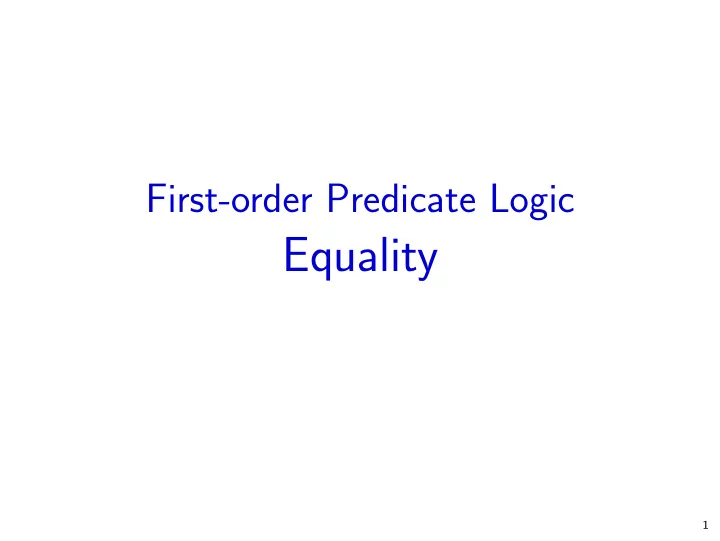

First-order Predicate Logic Equality 1
Predicate logic with equality Predicate logic + distinguished predicate symbol “ = ” of arity 2 Semantics: A structure A of predicate logic with equality always maps the predicate symbol = to the identity relation: A ( = ) = { ( d , d ) | d ∈ U A } 2
Expressivity Fact A structure is model of ∃ x ∀ y x = y iff its universe is a singleton. Theorem Every satisfiable formula of predicate logic has a countably infinite model. Proof Let F be satisfiable. We assume w.l.o.g. that F = ∀ x 1 . . . ∀ x n F ∗ and the variables occurring in F ∗ are exactly x 1 , . . . , x n . (If necessary bring F into closed Skolem form). We consider two cases: n = 0. Exercise. n > 0. Let G = ∀ x 1 . . . ∀ x n F ∗ [ f ( x 1 ) / x 1 ], where f is a function symbol that does not occur in F ∗ . G is satisfiable (why?) and T ( G ) is countably infinite. It follows from the fundamental theorem that G has a countably infinite model. 3
Modelling equality Let F be a formula of predicate logic with equality. Let Eq be a predicate symbol that does not occur in F . Let E F be the conjunction of the following formulas: ∀ x Eq ( x , x ) ∀ x ∀ y ( Eq ( x , y ) → Eq ( y , x )) ∀ x ∀ y ∀ z (( Eq ( x , y ) ∧ Eq ( y , z )) → Eq ( x , z )) For every function symbol f in F of arity n and every 1 ≤ i ≤ n : ∀ x 1 . . . ∀ x n ∀ y ( Eq ( x i , y ) → Eq ( f ( x 1 , . . . , x i , . . . x n ) , f ( x 1 , . . . , y , . . . , x n ))) For every predicate symbol P in F of arity n and every 1 ≤ i ≤ n : ∀ x 1 . . . ∀ x n ∀ y ( Eq ( x i , y ) → ( P ( x 1 , . . . , x i , . . . , x n ) ↔ P ( x 1 , . . . , y , . . . , x n ))) E F expresses that Eq is a congruence relation on the symbols in F . 4
Quotient structure Definition Let A be a structure and ∼ an equivalence relation on U A that is a congruence relation for all the predicate and function symbols defined by I A . The quotient structure A / ∼ is defined as follows: ◮ U A / ∼ = { [ u ] ∼ | u ∈ U A } where [ u ] ∼ = { v ∈ U A | u ∼ v } ◮ For every function symbol f defined by I A : f A / ∼ ([ d 1 ] ∼ , . . . , [ d n ] ∼ ) = [ f A ( d 1 , . . . , d n )] ∼ ◮ For every predicate symbol P defined by I A : P A / ∼ ([ d 1 ] ∼ , . . . , [ d n ] ∼ ) = P A ( d 1 , . . . , d n ) ◮ For every variable x defined by I A : x A / ∼ = [ x A ] ∼ Lemma A / ∼ ( t ) = [ A ( t )] ∼ Lemma A / ∼ ( F ) = A ( F ) 5
Theorem The formulas F and E F ∧ F [ Eq / = ] are equisatisfiable. Proof We show that if E F ∧ F [ Eq / = ] is sat., then F is satisfiable. Assume A | = E F ∧ F [ Eq / = ]. ⇒ Eq A is an congruence relation. Let B = A / Eq A (extended with = interpreted as identity). ⇒ B | = F [ Eq / = ] By construction Eq B is identity. ⇒ B ( F [ Eq / = ]) = B ( F ) ⇒ B | = F 6
Recommend
More recommend